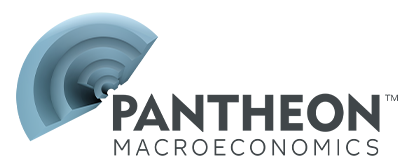US Publications
Below is a list of our US Publications for the last 5 months. If you are looking for reports older than 5 months please email info@pantheonmacro.com, or contact your account rep
Please use the filters on the right to search for a specific date or topic.
- Home sales have remained very weak despite recoveries in both supply and mortgage applications.
- That suggests to us that asking prices are too high, and need to come down for the market to clear.
- Home prices have already fallen by about 1% since March and we think a further grind lower lies ahead.
- The One Big Beautiful Bill Act includes sharp cuts to federal health spending, mostly affecting Medicaid.
- That will probably be a minor long-term headwind for the sector in the coming years.
- But the hit will take time to arrive, and the long-term tailwind from an ageing population looks far bigger.
THE ECONOMY WILL REMAIN STUCK IN A LOW GEAR IN H2
- UNEMPLOYMENT WILL WORRY THE FED MORE THAN INFLATION
The outlook for homebuilding remains grim.
- Foreigners are not “paying” for President Trump’s tariffs: pre-tariff import prices are holding steady…
- …That leaves US consumers and businesses shouldering nearly all of the additional costs.
- Homebase data point to a rebound in private payrolls, but likely give a misleading signal.
Price pressures are building, but July's data overstate the intensity.
- Growth in consumers’ real spending has stabilized following in sharp slowdown in H1 2025...
- ...But the labor market is set to remain weak, and most of the uplift to prices from tariffs lies ahead.
- We think spending will grow only at a meager 1-to-1½% pace in second half of this year.
- We estimate the core PCE deflator rose by 0.26% in July; most relevant PPI components rose modestly.
- The rise in distributors’ margins in the PPI is implausible, given surging tariff revenues and CPI data.
- We think hopes for a near-term “reshoring boost” to manufacturing look misplaced.
Collapsing response rate casts doubt, but the backdrop looks weak.
- We estimate that AI-linked investment lifted GDP growth in H1 2025 by about half a percentage point.
- The aggressive capex plans of the big tech firms suggest a similar boost in the coming quarters.
- July's PPI data likely will show that retailers’ and wholesalers’ margins are being squeezed by tariffs.
- Pass-through from the tariffs to consumer prices slowed in July, but will re-accelerate in the fall.
- The rebound in airline fares has further to run, but services inflation otherwise looks set to moderate.
- The FOMC likely will ease policy next month, despite more tariff-led inflation, to support the labor market.
- We look for a 1% gain in headline retail sales in July, mostly due to a rebound in auto sales…
- …But underlying sales likely were relatively weak again, with control sales volumes broadly stagnating.
- We think consumers' spending will grow by ½-to-1% in Q3, in keeping with the subdued pace in H1.
- Adobe and PriceStats data point to a slowing passthrough from the tariffs to consumer prices...
- ...But the ISM services survey sends the opposite signal; we are taking the middle position.
- Demand for air travel seems to be recovering, but hotel room rates likely are sustainably lower.
Flattered by GDP distortions in Q2, but the underlying trend still is solid.
- This year’s consumer slowdown has little to do with worries about taxes, more with trade and tariffs.
- The recent recovery in sentiment reduces recession risk, but the outlook for spending still is dim.
- Rising continuing claims reinforce the idea that the labor market has loosened materially.
Probably a false alarm on services inflation.
- Swings in home prices have a far bigger dollar-for-dollar wealth effect than movements in stock prices.
- Ongoing weakness in the housing implies a trivial boost to consumption from asset prices in H2 2025.
- Labor-matching efficiency is impeded slightly by high new mortgage rates, but is comparable to the 2010s.
- China’s share of US imports has collapsed to just 7%, from 13%, but looks set to rebound soon.
- Some importers likely have gamed the de minimis exemption, but the loophole will close later this month.
- Services inflation likely will remain contained, despite the further increase in the ISM prices index.
- The average effective tariff rate has risen to 19%, from 16% a month ago; risks tilt towards a further rise.
- Shifting trade flows, margin compression and price rises abroad will temper the boost to consumer prices.
- The DOGE cuts were a small but significant drag on GDP in Q2, and probably will be again in Q3.
